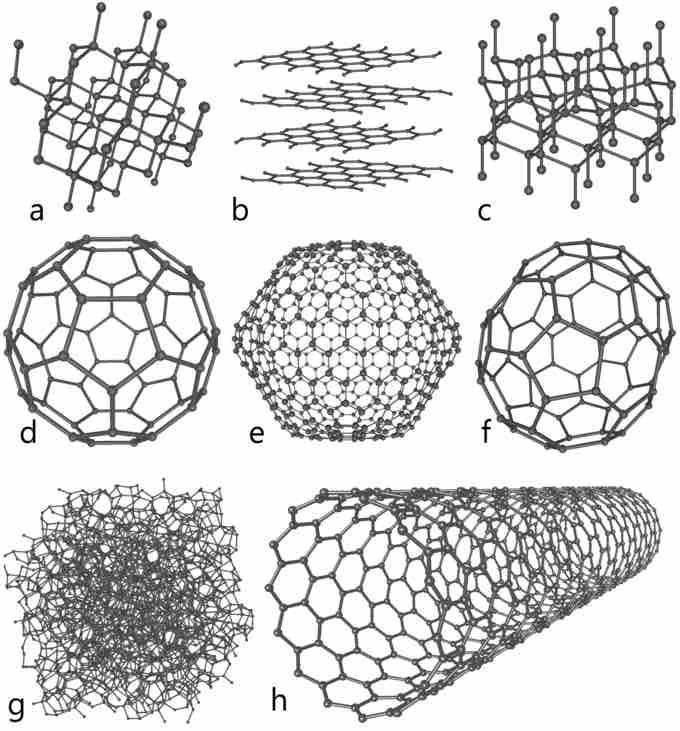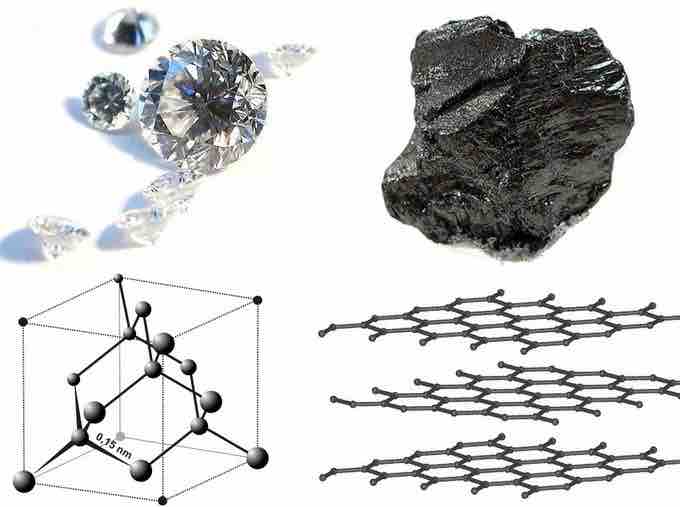Allotropy is the property of some chemical elements to exist in two or more different forms, or allotropes, when found in nature. There are several allotropes of carbon.

Allotropes of Carbon
Allotropes of carbon: a) Diamond, b) Graphite, c) Lonsdaleite, d) C60 (Buckminsterfullerene or buckyball), e) C540, f) C70, g) Amorphous carbon, and h) single-walled carbon nanotube, or buckytube.
Diamond
Diamond is probably the most well known carbon allotrope. The carbon atoms are arranged in a lattice, which is a variation of the face-centered cubic crystal structure. It has superlative physical qualities, most of which originate from the strong covalent bonding between its atoms. Each carbon atom in a diamond is covalently bonded to four other carbons in a tetrahedron. These tetrahedrons together form a three-dimensional network of six-membered carbon rings in the chair conformation, allowing for zero bond-angle strain. This stable network of covalent bonds and hexagonal rings is the reason that diamond is so incredibly strong as a substance.
As a result, diamond exhibits the highest hardness and thermal conductivity of any bulk material. In addition, its rigid lattice prevents contamination by many elements. The surface of diamond is lipophillic and hydrophobic, which means it cannot get wet by water but can be in oil. Diamonds do not generally react with any chemical reagents, including strong acids and bases. Uses of diamond include cutting, drilling, and grinding; jewelry; and in the semi-conductor industry.

Diamond and Graphite
Diamond and graphite are two allotropes of carbon -- pure forms of the same element that differ in structure.
Graphite
Graphite is another allotrope of carbon; unlike diamond, it is an electrical conductor and a semi-metal. Graphite is the most stable form of carbon under standard conditions and is used in thermochemistry as the standard state for defining the heat of formation of carbon compounds. There are three types of natural graphite:
- Crystalline flake graphite: isolated, flat, plate-like particles with hexagonal edges
- Amorphous graphite: fine particles, the result of thermal metamorphism of coal; sometimes called meta-anthracite
- Lump or vein graphite: occurs in fissure veins or fractures, appears as growths of fibrous or acicular crystalline aggregates
Graphite has a layered, planar structure. In each layer, the carbon atoms are arranged in a hexagonal lattice with separation of 0.142 nm, and the distance between planes (layers) is 0.335 nm. The two known forms of graphite, alpha (hexagonal) and beta (rhombohedral), have very similar physical properties (except that the layers stack slightly differently). The hexagonal graphite may be either flat or buckled. The alpha form can be converted to the beta form through mechanical treatment, and the beta form reverts to the alpha form when it is heated above 1300 °C. Graphite can conduct electricity due to the vast electron delocalization within the carbon layers; as the electrons are free to move, electricity moves through the plane of the layers. Graphite also has self-lubricating and dry lubricating properties. Graphite has applications in prosthetic blood-containing materials and heat-resistant materials as it can resist temperatures up to 3000 °C.
A single layer of graphite is called graphene. This material displays extraordinary electrical, thermal, and physical properties. It is an allotrope of carbon whose structure is a single planar sheet of sp2 bonded carbon atoms that are densely packed in a honeycomb crystal lattice. The carbon-carbon bond length in graphene is ~0.142 nm, and these sheets stack to form graphite with an interplanar spacing of 0.335 nm. Graphene is the basic structural element of carbon allotropes such as graphite, charcoal, carbon nanotubes, and fullerenes. Graphene is a semi-metal or zero-gap semiconductor, allowing it to display high electron mobility at room temperature. Graphene is an exciting new class of material whose unique properties make it the subject of ongoing research in many laboratories.
Amorphous Carbon
Amorphous carbon refers to carbon that does not have a crystalline structure. Even though amorphous carbon can be manufactured, there still exist some microscopic crystals of graphite-like or diamond-like carbon. The properties of amorphous carbon depend on the ratio of sp2 to sp3 hybridized bonds present in the material. Graphite consists purely of sp2 hybridized bonds, whereas diamond consists purely of sp3 hybridized bonds. Materials that are high in sp3 hybridized bonds are referred to as tetrahedral amorphous carbon (owing to the tetrahedral shape formed by sp3 hybridized bonds), or diamond-like carbon (owing to the similarity of many of its physical properties to those of diamond).
Fullerenes and Nanotubes
Carbon nanomaterials make up another class of carbon allotropes. Fullerenes (also called buckyballs) are molecules of varying sizes composed entirely of carbon that take on the form of hollow spheres, ellipsoids, or tubes. Buckyballs and buckytubes have been the subject of intense research, both because of their unique chemistry and for their technological applications, especially in materials science, electronics, and nanotechnology. Carbon nanotubes are cylindrical carbon molecules that exhibit extraordinary strength and unique electrical properties and are efficient conductors of heat. Carbon nanobuds are newly discovered allotropes in which fullerene-like "buds" are covalently attached to the outer side walls of a carbon nanotube. Nanobuds therefore exhibit properties of both nanotubes and fullerenes.
Glassy Carbon
Glassy or vitreous carbon is a class of carbon widely used as an electrode material in electrochemistry as well as in prosthetic devices and high-temperature crucibles. Its most important properties are high temperature resistance, hardness, low density, low electrical resistance, low friction, low thermal resistance, extreme resistance to chemical attack, and impermeability to gases and liquids.
Other Allotropes
Other allotropes of carbon include carbon nanofoam, which is a low-density cluster assembly of carbon atoms strung together in a loose three-dimensional web; pure atomic and diatomic carbon; and linear acetylenic carbon, which is a one-dimensional carbon polymer with the structure -(C:::C)n-.